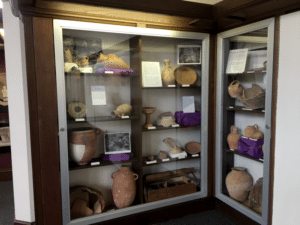
Excavations at Tell en-Nasbeh (1926-1935)

The core of the Museum collection consists of materials from the site of Tell en-Nasbeh (most likely the biblical town of Mizpah), excavated under the direction of William F. Badè. Dr. Badè’s work at Tell en-Nasbeh represents one of the earliest scientific excavations in Palestine. With a permit from the British Mandate Government’s Department of Antiquities, he was able to spend five seasons there from 1926 to 1935 and excavate two thirds of the eight-acre tell, or mound, exposing a small town that had been occupied at the time of the Hebrew monarchy.
Mizpah, in the region of Benjamin, flourished from 1000–586 B.C., and a massive fortification wall, impressive gateway, three and four-room houses, family tombs, pottery, and metal artifacts in great quantity date from this period, known as the Iron Age in Palestinian archaeology. Of the hundreds of lamps, pitchers, bowls, jars, jewelry and cosmetic items found in the ruins of the town, about half were deposited at the Rockefeller Museum in Jerusalem, while others were shipped to Berkeley. Those on display in the Bade Museum provide graphic evidence of everyday activities in a provincial town of three thousand years ago, and offer instructive comparison with life in this century.
 While the tell itself contained Iron Age, Babylonian and Persian Period artifacts, nearby tombs dated from the Early Bronze Age (3200–2000 B.C.) and the Hellenistic and Roman Periods (330 B.C.–324 A.D.). Some of these artifacts are on display, as well as representative pieces from other areas of the ancient Near East.
While the tell itself contained Iron Age, Babylonian and Persian Period artifacts, nearby tombs dated from the Early Bronze Age (3200–2000 B.C.) and the Hellenistic and Roman Periods (330 B.C.–324 A.D.). Some of these artifacts are on display, as well as representative pieces from other areas of the ancient Near East.
At the close of each season of excavation, after artifacts were removed, the soil was replaced on the mound. Only one section of the huge town wall, deliberately left exposed, is visible at the site today. Dr. Badè’s original intention that the excavation and its results become an educational resource is fulfilled through the Badè Museum and its on-going research of material from Tell en-Nasbeh, where important aspects of ancient households, gender, and daily activities can be understood in new and exciting ways.
Excavation Film
This video is a compilation of two reels of silent excavation footage filmed by George Hedley and James Philmore Collins during the 1926 and 1935 seasons at Tell en-Nasbeh. These silent films are a treasure not only for their documentation of the burgeoning archaeological field of the early twentieth century, but for the window it provides on landscapes and life-ways seemingly vanished from this region now overrun with urbanization. Images of excavations at Tell en-Nasbeh commingle with traditional Palestinian dancing, Bedouin bread making and Jerusalem street scenes that act as a historical narrative transferred without words.
